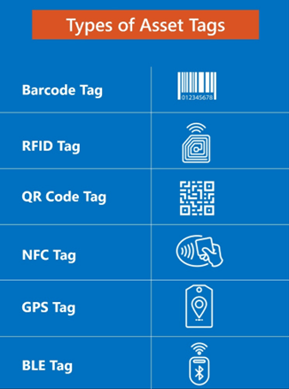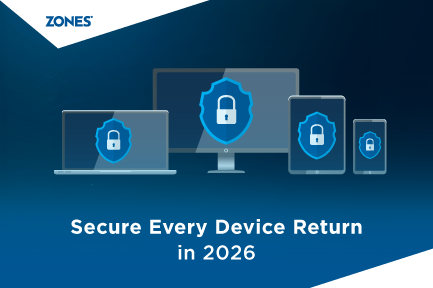12 IT Asset Tracking Mistakes to Avoid in 2026 (and How to Fix Them)
In a hybrid, device-driven, and sustainability-focused world, IT asset tracking has become a critical business capability rather than an operational...
5 min read
![]() Zones
:
Feb 23, 2024 11:55:31 AM
Zones
:
Feb 23, 2024 11:55:31 AM

Modern-day enterprises find managing and tracking their IT assets challenging due to geographically dispersed operations and a continual increase in assets over time. Improper tracking and management of these assets can negatively impact operational efficiency.
This is why enterprises should consider implementing a robust asset management strategy like asset tagging that enables organizations to track IT hardware, ensure compliance, and gain insights into technology spending.
According to Research and Markets, the global asset tracking market is estimated to reach $36.3B by 2025 as businesses begin to understand how essential and beneficial asset tracking can be to their operations.
Asset tagging is the process of assigning unique identifiers or tags to hardware devices to facilitate monitoring and maintenance. These are generally adhesive labels containing a distinct identification like a barcode, QR code, or RFID assigned per device. Tags store attributes like serial numbers and model details that are readable by scanning. Tags are applied directly and secured in a tamper-proof style.
In the growing digital ecosystem of enterprises, where the volume of IT assets can be overwhelming, asset tagging provides a systematic and organized approach to effective asset management.
Here are a few benefits of implementing asset tagging:
In an era where data breaches and cyber threats are rampant, maintaining the security of IT assets is paramount. Asset tagging aids in asset identification and ensures that security protocols are enforced. This is particularly crucial in preventing unauthorized access to sensitive information.
It facilitates proactive maintenance by providing a comprehensive record of each asset's history. This helps schedule timely maintenance and repairs, reduces downtime, and ensures that assets are operating optimally.
Asset tagging minimizes the time spent searching for and managing assets. With a well-implemented tagging system, organizations can quickly locate assets, reducing downtime and increasing overall operational efficiency. This, in turn, translates into cost savings.
It aids in accurate financial reporting by providing a clear picture of the organization's assets. This is crucial for budgeting, financial planning, and compliance with accounting standards.
Many industries have stringent regulatory requirements, and compliance is non-negotiable. Asset tagging ensures that organizations can easily demonstrate adherence to regulations through accurate records, simplifying the auditing process.
Asset tags come in various forms, each catering to specific needs and environments. Understanding the different tag types is essential for implementing an effective asset tagging strategy.
Here are some common asset tagging types:
These tags contain a barcode that can be scanned for quick and accurate asset identification. Barcode tags are cost-effective and widely used for inventory management.
Radio frequency identification (RFID) asset tags provide unique IDs that are readable from longer distances using radio signals. More expensive than barcoding, this type of tag is ideal for tracking assets in real-time and is commonly used in large enterprises with complex asset inventories.
Similar to barcodes, QR codes store more information and can be scanned using a smartphone or dedicated scanner. QR codes hold substantial data within a small footprint at lower costs than RFID.
Near Field Communication (NFC) tags need only close contact with NFC-enabled scanners for identification. The compact design adheres firmly to assets. They are commonly used in asset tracking where close proximity is required owing to security concerns.
Global Positioning System (GPS) tags are used for real-time tracking of assets with location-based requirements. These tags transmit location data, enabling precise tracking of hardware assets.
Bluetooth Low Energy (BLE) tags are tracked using Bluetooth-based relays that enable devices to communicate wirelessly with the central server over short distances, making them suitable for tracking and monitoring IT assets.

To ensure smooth asset tagging, organizations should adhere to the following best practices:
Establish enterprise-wide standards covering essential aspects such as a person in charge, protocols of reporting issues,; scope of tagging, and chain of custody for deployment, relocation, and decommissioning.
Conduct asset audits to identify high- and low-risk items by running domain and network scans for devices and peripherals. Since a physical stock check is challenging in remote work, it is advisable to check asset positions with employees and tag only the ones that can be tracked without human intervention.
Identify and categorize your assets to maintain consistent classification. Assets can be grouped based on department, cost, usage, or other variables.
In addition to categorizing and classifying assets, assigning a unique identification number to each asset is crucial for precise tracking. This distinct ID sets apart individual assets within the same category and type, streamlining processes like reordering, maintenance, and accounting.
Various types of asset tags suit specific requirements and asset conditions. Determining the tag type for universal tracking and monitoring of assets across locations is crucial to avoid further changes and repercussions.
Establish standardized procedures for tagging assets consistently across the organization. This consistency ensures uniformity and ease of tracking. Also, adopt consistent materials, taxonomy, codes, and integration formats across all geographies.
In addition to the asset tag ID, record corresponding serial numbers, make and model numbers, cost, specification parameters, designated owner, item age, condition, and supplementary details. This will help IT asset management (ITAM) teams determine new equipment requirements and decommission older assets.
Asset tags must endure rough product lifecycles. Hence, it is advisable to attach tags to durable and visible sections of device exteriors.
Connect handheld barcode scanners, RFID sensors, and software inventory tools into a central asset management solution for unified data management, reporting, and analysis.
Conducting regular audits can help verify the accuracy and integrity of asset data and update information as needed, such as missing, damaged, or swapped tags. This proactive approach helps maintain the integrity of the asset database.
Implement measures to safeguard asset data by encrypting and controlling user access to prevent unauthorized tampering of asset tags or information.
When it comes to asset tagging, organizations follow different methodologies depending on the nature of the assets and the organization's requirements. These are:
Assets are assigned tags sequentially, making it easy to predict and identify tag numbers. This method is straightforward and suitable for organizations with relatively few assets.
Tags are assigned randomly without a predefined sequence. This method enhances security by making it difficult for unauthorized individuals to predict tag numbers. Random tagging is often used in larger organizations with diverse and extensive asset inventories.
The assets are tagged with barcode/RFID tags at a central IT facility or warehouse before being deployed to users. The central team configures devices and applies tags per standardized naming conventions and settings, allowing consistency; however, this method lacks flexibility for location-specific customization needs.
The IT staff assigns the tags to assets locally at the end-user site. This method is useful when assets need customized configurations that vary across locations. However, it is prone to inconsistencies without centralized control.
The initial base tagging is done centrally as configured devices are shipped to locations. The local staff then attach secondary tags to indicate site-specific details like subnet and equipment IDs. This method requires coordination between central and distributed IT teams.
Selecting the right asset tagging partner is crucial for the success of your asset management initiative. Consider the following factors when choosing your IT asset tagging and management partner:
Choose a partner with a proven track record in asset tagging and management. Look for expertise in handling projects similar to your organization's size and industry.
Ensure the partner's solutions can scale to accommodate your organization's growth. A scalable solution is essential for adapting to changing business needs and expanding IT infrastructure.
Verify that the partner understands your existing IT infrastructure and asset management systems. Make sure that they provide complete asset lifecycle support to avoid discrepancies.
Confirm that the partner adheres to industry standards and regulations related to data security and privacy. Compliance is particularly crucial in industries with strict regulatory requirements.
Evaluate the level of customer support and training provided by the partner. A reliable partner should offer ongoing support, training programs, and resources to ensure the successful adoption of asset tagging within your organization.
Asset tagging is a fundamental component of effective IT integration and the lifecycle management of IT assets. By providing enhanced visibility, accountability, and security, asset tagging contributes to operational efficiency and cost savings.
Choosing the right asset tagging partner is a strategic decision that requires careful consideration of factors such as experience, scalability, technology integration, compliance, and customer support. As organizations embrace the digital transformation journey, asset tagging becomes increasingly pivotal in optimizing resource utilization and ensuring the longevity of IT assets.
For end-to-end IT asset management solutions, turn to integrated solution leaders like Zones.
In a hybrid, device-driven, and sustainability-focused world, IT asset tracking has become a critical business capability rather than an operational...

The optimal performance of data-bearing IT assets is crucial to an organization’s operational efficiency. This is why these assets require a secure...

As hybrid work expands and device footprints grow, IT teams are facing a challenge in secure retrieval, recovery, and return of devices during...